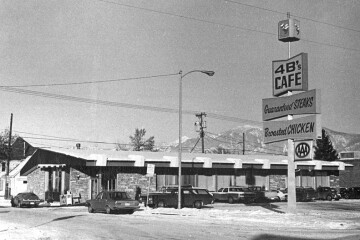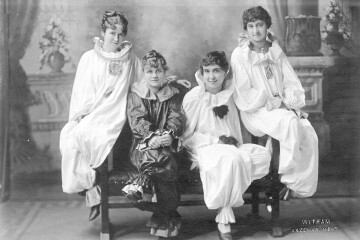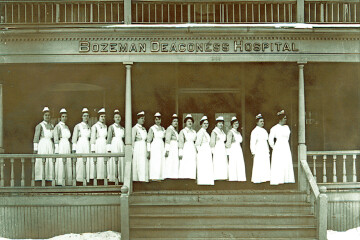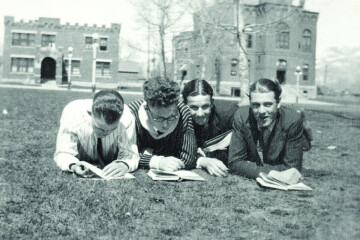Gallatin History Timeline

Gallatin County is a unique place. Throughout our history, environmental and geographical attributes intersected and interacted with the people who lived here, creating new ideas and opportunities. This timeline showcases some of the important events in our history—how people and environment mixed to create Gallatin County’s unique story.
Pre-White Settlement Madison Buffalo Jump
Native people, including the Piegan, Shoshone, Salish, and Crow, regularly hunted in and traveled through the Gallatin Valley. Snowmelt from nearby mountains fed numerous rivers and streams and the tall grass attracted bison, deer and elk. For 2,000 years, the cliffs of the Madison Buffalo Jump furnished an efficient way for native people to hunt bison, providing food, shelter and clothing.
1805 Lewis and Clark Expedition
Lewis and Clark reached the headwaters of the Missouri River at Three Forks in July 1805 and named the three large rivers converging there Jefferson (for President Thomas Jefferson), Madison (for Secretary of State James Madison), and Gallatin (for Secretary of the Treasury Albert Gallatin). The Expedition took note of the fertile valley with its abundant waterways and beaver.
1840s Fur Trade
Eager to capitalize on the popularity of beaver pelts in fashion trends, mountain men like Jim Bridger roamed the Rocky Mountains trapping and trading. In the 1860s, Bridger would himself lead settlers to the Gallatin Valley on the Bridger Trail, which passed on the west side of the Big Horn Mountains in Wyoming and into the Gallatin Valley through the mountain range near Bozeman that today bears his name.
1862-1863 Gold Rush Begins
Gold was discovered in what would later become southwest Montana in 1862 (Bannack) and 1863 (Alder Gulch). Within months, thousands of miners flooded the area – among them an ambitious Georgian named John Bozeman.
1862 Gallatin City
Gallatin County’s first settlement, Gallatin City, was established near the headwaters of the Missouri River in 1862. Nearby waterways and wagon routes to Alder Gulch, Last Chance Gulch (Helena), and Fort Benton made Gallatin City a convenient stage stop and way station for early Montana travelers. The settlement featured a hotel, store and flour mill. Gallatin City served as the first county seat until 1867, when voters transferred the honor to Bozeman.
1864 Bozeman Established
John Bozeman and John Jacobs, an experienced mountain man, adopted the Bozeman Trail as a quicker route to the booming gold-mining camps of Virginia City (Alder Gulch) and Bannack. Though 800 miles shorter than Jim Bridger’s trail, the route itself was problematic as it trespassed through Sioux, Crow, and Cheyenne treaty-held territories. Late in 1863, John Bozeman met visionaries Daniel Rouse and William Beall. The three agreed that the eastern end of the Gallatin Valley was a prime location for a settlement catering to trail-worn immigrants. Many weary travelers decided to plant roots in the Gallatin Valley and “mine the miners” instead of continuing on to Virginia City to mine gold. Farmers grew crops in the fertile soil at the foot of the Bridger Mountains, while merchants and entrepreneurs built general stores, mills, boardinghouses, and saloons.
1867 Fort Ellis
After John Bozeman’s untimely death in 1867, area citizens pushed the federal government to build a fort near town. Fort Ellis was in operation by the end of the summer, but its greatest value proved to be economic rather than protective. In addition to providing a stable and convenient market for local ranchers, the fort housed soldiers who journeyed into town to spend their money. Tragically, in January 1870, 2nd U.S. Cavalry troops from Fort Ellis participated in the Baker Massacre along the Marias River in northern Montana. Soldiers attacked an innocent Piegan village, killing 217 men, women and children.
1872 Yellowstone National Park
The world’s first national park was created in 1872, just 90 miles from Bozeman. Part of the 1872 Hayden Survey party departed from Fort Ellis in July, and proceeded to explore, map, photograph, and record the wonders of the new park for a national audience.
1872 Bozeman’s First Bank
Bozeman’s first bank, the First National Bank, opened for business in 1872, just months after the establishment of Yellowstone National Park. The institution closed in 1878, but was closely followed by others, including Bozeman National Bank and Gallatin Valley National Bank (1882), Commercial National Bank (1892), and Gallatin State Bank (1902). The 1912 city directory lists nine banks in the Gallatin Valley – one in Belgrade, three in Bozeman, two in Three Forks, two in Manhattan, and one in Salesville (Gallatin Gateway).
1883 Northern Pacific Railroad
The first Northern Pacific Railroad engine steamed into Bozeman on March 14, 1883. Construction boomed as the railroad provided easy shipping opportunities and sparked new confidence in future economic growth. In addition, the railroad expanded the market for local agricultural products and provided easier access to Yellowstone National Park.
1890 Manhattan Malting Company
By the late 1880s, word of Gallatin Valley’s rich agricultural land had spread outside Montana. In 1890, New York maltsters and brewers formed the Manhattan Malting Company, located near the small settlement of Moreland in western Gallatin County. The investors purchased land, formed the West Gallatin Irrigation Company to construct a massive irrigation canal, and built elevators and a malting plant. The settlement was soon renamed Manhattan after the Manhattan Club in New York City. The Manhattan Malting Company recruited farmers from Holland to settle in Gallatin County and grow high quality barley. The Malting Company thrived until 1919, when prohibition laws halted operations.
1892 Bozeman Streetcar
In the early 1890s, Bozeman competed fiercely with Helena, Anaconda, and Butte for the honor of being named the state capital. In the fervor of competition, city leaders transformed the modest farm and ranch community into a sophisticated city and installed a modern electric streetcar line. Bozeman’s modern trolley system transported passengers from the Northern Pacific Depot (North Ida Ave. and Front Street) to Main Street (via Church Avenue) and then up 9th Avenue. The track later expanded to include north and south Bozeman Avenues, Peach Street, Rouse Avenue, South Grand Avenue, West Alderson Street, and South 7th Avenue.
1893 Montana Ag College (MSU)
Despite its efforts, Bozeman lost the state capital competition. However, it did gain an incredible asset in 1893—a land grant school named Montana State College of Agriculture and Mechanic Arts. The low hill south of town that was originally intended for the state capitol building soon became home to Montana State College (later named Montana State University).
1896 Bozeman’s 1st Hospital
Dr. Henry Foster arrived in Bozeman in 1882. He performed a successful cesarean section in town in 1893 – likely the first such procedure in the state. Foster quickly gained notoriety and in 1896, he constructed a hospital on the corner of Lamme Street and North Tracy Avenue. The hospital accommodated 20 patients, provided hot water and electricity, and boasted colorful wall and ceiling frescoes.
1906 Sweet Pea Carnival
The Sweet Pea Carnival began in 1906 as a signature summer event meant to stimulate local commerce. Each year through 1916, excited locals adorned Main Street with streamers, coated carriages and automobiles in paper sweet pea blossoms, and crowned a Sweet Pea Queen. In 1918 and 1919, World War I and the Spanish Influenza pandemic halted Sweet Pea celebrations. In 1977, after a sixty-year hiatus, the Sweet Pea Festival was revived.
1909 Gallatin Valley Electric Railway
The Gallatin Valley boasted Montana’s only interurban railway line, which began service in 1909. The GVER Depot was located on East Main Street, near where the Bozeman Public Library sits today. The interurban railway connected Bozeman with Salesville (Gallatin Gateway), Bozeman Hot Springs, Three Forks, Logan, Manhattan, Belgrade, Springhill, and Menard. Passengers easily traveled throughout the Gallatin Valley and spur lines provided local farmers and ranchers with a convenient way to transport cattle and wheat to the Milwaukee main line at Three Forks and the Northern Pacific Railroad freight yard in Bozeman.
1947 First Commercial Flight at Gallatin Field Airport
Gallatin County’s first airport, Siefert Airport near Belgrade, was dedicated on April 21, 1928, and named for local aviation pioneer Wayne Siefert. A second airport replaced the first one a year later and was equipped with six runways. The airport moved a third time in 1942, when officials took advantage of favorable area weather conditions and a natural gravel bar just east of Belgrade. The new airport was named Gallatin Field. On June 22, 1947, Northwest Airlines provided the first commercial flight to the Gallatin Valley and a large celebration was held at Gallatin Field. Those attending the festivities enjoyed a parade and a chuckwagon breakfast.
1970 Big Sky
In early 1970, NBC news anchor Chet Huntley, along with the Chrysler Realty Corporation and other investors, established Big Sky of Montana, Inc. In the early 1970s, construction commenced on the Big Sky resort in Gallatin Canyon, partway between Bozeman and West Yellowstone. Development included downhill ski runs and lifts, condominiums, restaurants, shops, and eventually a golf course. Chet Huntley died on March 20, 1974, shortly before Big Sky Resort was formally dedicated.
2017 Gallatin Historical Society Celebrates 40 Years
The Gallatin Historical Society was founded in 1977 and soon transformed the old county jail building into a museum, which continues to operate on Main Street today. For more information about these and other events in Gallatin County history, visit the Gallatin History Museum at 317 W. Main St. in Bozeman. For a fun timeline video clip, visit https://www.youtube.com/watch?v=1XI844IV9tE.








